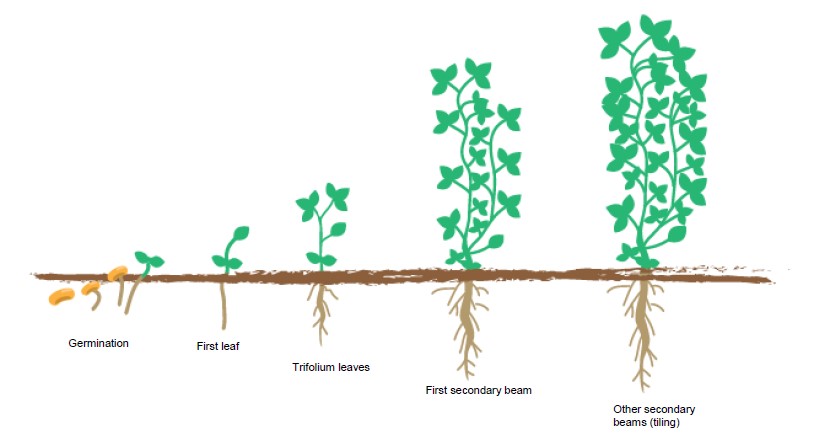- Home
- Knowledge library
- Managing lucerne
Managing lucerne

Managing lucerne
It is vital to control weeds, pests and diseases in a lucerne stand to avoid yield reductions and to prolong the lifespan of your crop.
When grazing or conserving lucerne, maintain a minimum sward height of 6–7 cm to avoid damaging the crown.
Growing cycle
The first leaf is different, usually described as the ‘spade’ shaped leaf; following leaves are trifoliate and the first to third trifoliate leaf stages are important for herbicide timing.

Weed control
Several herbicides are approved for use on lucerne, including propyzamide and carbetamide. They should be applied to an established crop during the winter dormancy period. They are effective on grass and some broadleaved weeds, with some residual control into the spring. There are also some ‘extension of authorisation of use’ (EAMU) permissions; for example, fluazifop-p-butyl, a contact herbicide for grass weeds.
Pesticides cleared for use on lucerne
| Chemical (example products) | Reason/use | Maximum rate/ha (litres) | Usual rate/ha (litres) | Harvest interval or latest date | Notes |
|---|---|---|---|---|---|
|
Propyzamide (e.g. Kerb Flo) |
1.75 |
1.5 |
1 October to 31 January (a) |
Established crops. Check with agronomist as only certain products are approved |
|
|
Centurion Max (EAMU only) |
Grass weeds |
2.0 |
1.0 |
|
When blackgrass is at four to six leaves (adhere to the label) |
|
2,4-DB 400g/l (e.g. DB Straight, Headland Spruce, Butoxone DB) |
Oilseed rape, charlock (b) and shepherd’s purse |
4.5 |
2.0–3.0 |
|
First to fourth trifoliate leaf stage |
|
Diquat* (e.g. Reglone) |
Total weed control (c) |
2.0 |
2.0 |
31 March (d) |
During dormant phase of crop |
|
Fluazifop-p-butyl* (e.g. Fusilade Max) |
Grass weed control (e) (not meadow grass) |
3.0 |
0.5–1.0 |
52 days before grazing or cutting |
Should be used before end of October or before mid-June |
Source: Limagrain, Germinal GB Ltd and Dengie Crops Ltd
Always consult a BASIS-qualified adviser on the use of agrochemicals to control weeds, pests or diseases.
To search for advisors in your area, check out the Association of Independent Crop Consultants.
Source: Compiled by Dengie Crops Ltd
(a) November to December best
(b) Use higher rate for charlock; poor on white mustard
(c) Keep livestock out of treated area for 24 hours
(d) Mid-December to mid-January best
(e) Unprotected persons to be kept out of treated area for 24 hours after treatment
* = off label use. Check with an agronomist before buying.
Note: Read label and obey conditions and restrictions. Check current position at https://secure.pesticides.gov.uk/offlabels/OffLabelList.as
Pest and disease control
The choice of agrochemicals to control pests and diseases in lucerne is limited and unless tramlines are used, there are few opportunities to enter the actively growing crop.
Good establishment is essential. You need to monitor growing crops closely and seek specialist agronomy advice if crops appear to be challenged in some way.
| Pest/disease | Effect | Action |
|---|---|---|
|
Sitona weevil larvae and leatherjackets |
May attack at an early stage in establishment, biting off young shoots
|
Consult an agronomist No insecticides are currently cleared Weevils can cause considerable damage to small lucerne plants |
|
May infest established crops |
No chemical approval exists at present |
|
|
A potential problem at initial establishment and should be monitored |
Slug pellets used when required |
|
|
Eelworm |
Can cause persistency problems Where infestations in the soil are known to occur, varietal resistance is the only practical solution More prevalent of heavier soils |
Always use fumigated seed to avoid importing eelworm to the soil and crop Consult an agronomist
|
|
Verticillium wilt |
Leaves wilt on warm days and become blotchy with yellow or brown markings. The plants eventually die |
Choose resistant varieties as there are no chemical treatments available |
|
Dodder (Cuscata) |
This parasitic plant has seed similar to lucerne and is difficult to remove from seed samples. It is rarely a serious problem in the UK as it multiplies rapidly at high temperatures (>30°C) after rainfall |
There are no control methods. Destroy any patches that develop with total herbicides and burning
|


